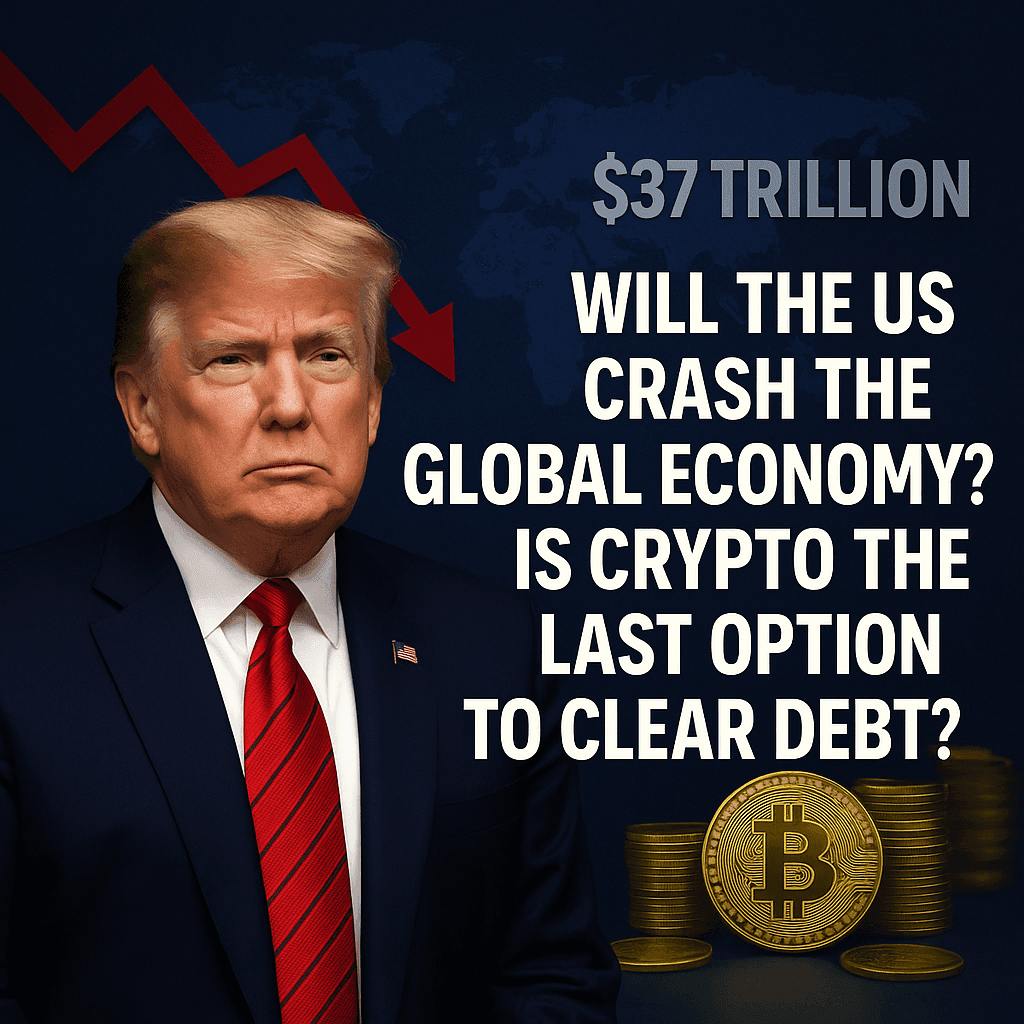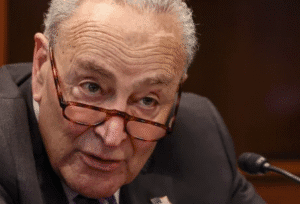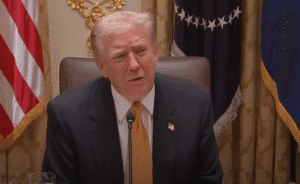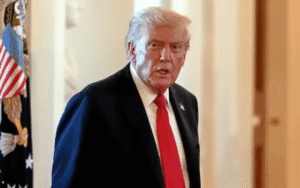Will the US Crash the Global Economy? Is Crypto the Last Option to Clear Debt?

The United States is facing a record-breaking national debt of $37 trillion, far exceeding its gross domestic product (GDP) of $30.3 trillion. This represents 119% of the nation’s total economic output, underscoring the scale of America’s fiscal challenge.
According to estimates from the U.S. Treasury, the debt could rise to $52 trillion by 2035 if current trends continue. The growing fiscal imbalance has reportedly caused unease within the Trump administration, which has been introducing sweeping policy changes to counter the crisis.
Trump’s Tariff Blitz Across 90 Nations
In a bid to increase government revenue and curb the trade deficit, President Donald Trump has imposed tariffs on 90 countries, targeting imports to boost domestic production.
- United Kingdom and China: 10% tariff
- Syria: 41% tariff
- India: highest at 50%
Trump insists these measures will generate additional tax revenue that can be directed toward repaying the national debt. Economists, however, remain skeptical, warning that tariffs could lead to retaliatory trade barriers and inflationary pressures on American consumers.
A Controversial “Crypto Solution”
While tariffs are a visible step, a controversial theory emerging from Moscow has attracted international attention. During a global economic forum in Russia on September 8, Russian Minister Anton Kobyakov claimed that the U.S. government may be planning to convert portions of its debt into cryptocurrency and stablecoins, with the goal of “devaluing” it.
According to Kobyakov, Washington’s strategy involves rewriting global rules for crypto and gold markets to ease its debt burden amid growing dedollarization trends. He suggested that by creating a digital “crypto cloud,” the U.S. could theoretically transform a large portion of its $37 trillion debt into digital assets, gradually reducing its real-world value through market mechanisms.
No official U.S. statement has confirmed this claim, but analysts note that such a move would echo past American financial maneuvers designed to stabilize the economy at the world’s expense.
America’s Debt Built on Borrowing and Wars
Historical data from the U.S. Treasury shows that America’s debt has been growing steadily since its independence, with major spikes during wars and recessions.
- After the Civil War, debt rose from $60 million to $2.6 billion.
- Following World War I, it jumped to $25 billion, and during World War II, to $258 billion.
- By 1982, the Vietnam and Iran conflicts pushed it past $1 trillion.
- The 2008 financial crisis doubled the debt to $13.5 trillion, and COVID-19 spending lifted it above $30 trillion by 2022.
Economists say this pattern shows a consistent mismatch between federal spending and tax revenue. For example, in 2023 alone, the U.S. spent $381 billion more than it collected through taxes.
The Dollar Advantage
Despite its debt, the U.S. continues to operate effectively due to the U.S. dollar’s status as the world’s primary reserve currency. Roughly 58% of global foreign exchange reserves are held in U.S. dollars, giving Washington an unparalleled advantage in borrowing cheaply.
Foreign nations hold about $9.16 trillion in U.S. Treasury bonds, effectively financing America’s debt.
- Japan: $1.15 trillion
- United Kingdom: $899 billion
- China: $731 billion
- India: $219 billion
However, experts warn that if dedollarization efforts led by emerging economies such as the BRICS bloc gain traction, demand for U.S. Treasuries could fall, pushing up borrowing costs and worsening the debt spiral.
Devaluation Concerns and Historical Parallels
The concept of “devaluing debt” is not new. In 1934, President Franklin D. Roosevelt suspended the gold standard and criminalized private gold ownership, effectively devaluing the dollar to combat the Great Depression. Similarly, in the 1970s, President Richard Nixon ended the gold standard entirely, freeing the U.S. to print more currency and expand debt.
Analysts suggest a crypto-based strategy could function similarly by shifting debt into digital assets, then reducing their value through inflation or controlled depreciation. However, this could have devastating global consequences, transferring the burden of America’s debt onto international investors.
Trump’s Growing Interest in Crypto
In recent months, President Trump has publicly reversed his stance on cryptocurrency, which he once criticized. Reports indicate that Trump and his sons have co-founded a company called World Liberty Financial, holding a $5 billion stake in crypto assets.
Following Trump’s renewed endorsement of digital currencies, Bitcoin prices surged sharply, with analysts noting that his policies could intertwine national debt management with private financial interests.
What Lies Ahead
The U.S. government’s twin approach of raising tariffs and experimenting with digital financial instruments may provide short-term relief but could also deepen global market instability.
Economists warn that transforming sovereign debt into crypto-backed assets would be unprecedented and risky, potentially undermining international trust in the U.S. financial system.
For now, the world watches closely as Washington navigates its mounting fiscal storm, balancing between innovation and economic peril.
Other News
- Right-Wing Pundits Fall Into Line With One Desperate Message to Shield Trump
- Progressives Demand Chuck Schumer’s Resignation After He Caves to GOP in Shutdown Deal
- Trump’s Boldest Move Yet: Pardons for Giuliani, Meadows and 2020 “Alternate Electors”
- Trump’s Bombshell Plan: “Take Billions from Insurance Companies and Give It Directly to the People”
- Triggered Trump Explodes After Reporter Asks Why Americans Can’t Afford Groceries




